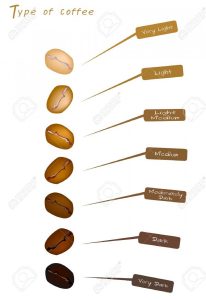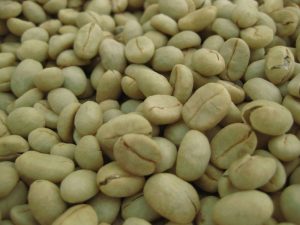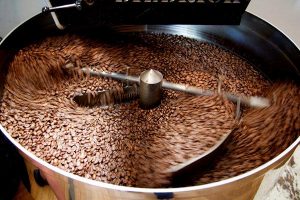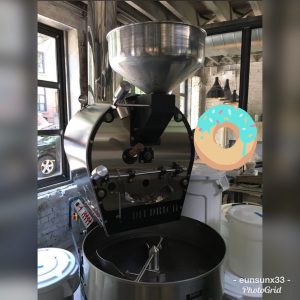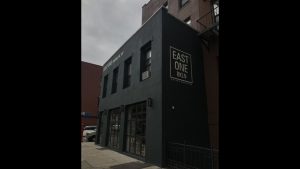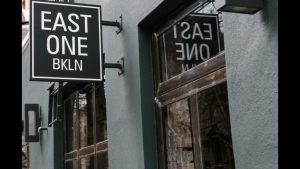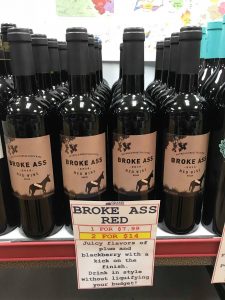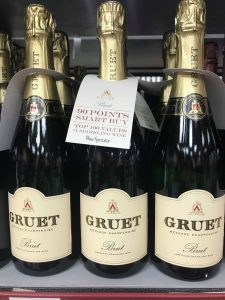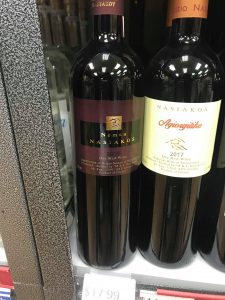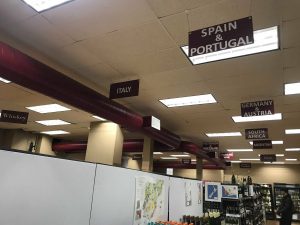For my Beverage Production Experiential Learning Analysis instead of visiting a winery like most people, I decided to go to a coffee roaster. The reason why I decided to visit a coffee roaster instead of a winery is because I work at a coffee shop and I wanted to have more knowledge of how coffees make that flavor they make. So the coffee roaster I decided to visit is East One Coffee Roaster. It is located at 384 Court St, Brooklyn, NY 11231. To get here you can take the F train to Carroll St and walk up to Carroll St and Court Street. It took me a while to get there because I was traveling down from Flushing. Before going to the place I did some research to make sure that they roasted coffees and I found out that they aren’t only a roaster, they are also a coffee shop, and an eatery. On google they got they got a 4.6 Star Rating, on yelp they have a 4 Star Rating, on trip advisor is 3.5 Star Rating, and on Facebook they have a 5 Star Rating. On Monday-Friday they are opened from 7AM to 7PM and on Saturday-Sundays they are opened from 8AM to 7PM. At this café they also have a eatery and a coffee roaster. The eatery hours are Monday-Friday they are opened from 8AM to 4PM and on Saturday-Sundays they are opened from 9AM to 4PM.
The owners of East One Coffee Roaster is Morten Tjelum and Tom Cummings. They have found NewRow and FreeState Coffee in London. So now they came to New York and made East One Coffee Roaster. The coffees aren’t roasted every day. They are roasted twice a week which are in the beginning of the week and the end of the week, which is Monday and Friday. You must make reservations to come see them roast the coffee, it is a private thing that they do. They also specialize in light to medium roast styles. For the coffee beans that they use to sell are from five main countries, which are Kenya, Ethiopia, Colombia, Costa Rica, and Guatemala.
So I asked why are the coffee beans green aren’t they supposed to be dark brown? The worker told me that the reason why its green is because that’s the color it is before it is roasted. Then I asked why is it so important to roast coffee, the worker told me that the roasting brings out the flavor and the aroma that was locked inside the coffee bean that is green. The beans are left at the color green so that they wont lose their taste or quality. A coffee bean that is roasted and not roasted weights different. The one that isn’t would be heavy while the one that is roasted isn’t heavy because the moisture was taken out during the roasting process. The beans that have been roasted should be used a quickly as possible so it can still be fresh. The longer you wait the flavors of the coffee will change.
There are four color categories which are light, medium, medium-dark and dark. The light roast is a light brown color it is preferred for milder coffee there is no oil on the surface because it hasn’t been roasted long for the oils to come out. The medium roast is a medium brown color it has a strong flavor and a non-oily surface. Medium dark roast is a dark in rich color there is some oils on the surface but when drinking there is a little bittersweet aftertaste. Dark roast is a shiny black been with a surface that is oily and is very bitter. The darker the roast is the less acidity could be found in the drink.
So I was curious of how a coffee is grown so I did a little research and found that it takes them about 3-4 years to become a newly planted coffee tree to have bear fruit, it is named coffee cherry. The coffee cherry will turn bright and it’ll turn dark red once it is ripped and ready to be harvest. There are two different ways for the coffee cherries to be picked, it is either strip picked, or selectively picked. For stripped picked all the cherries are stripped off the branch at once, either by hand or a machine. Selectively Picked is when only the ripped cherries are harvested, and they are picked by hand. The pickers rotate from tree to tree every 8-10 days, to only pick the cherries that are ripped. Once the coffee is picked they must begin to process right away so prevent any fruit from spoiling. The way coffee is processed into two ways which are dry method and wet method. The Dry Method is an age-old method, it is still used in many countries where water is very limited. The freshly picked cherries are spread out on a dry surface so it can dry in the sun. In order to make sure the coffee doesn’t spoil, it will be turned throughout the day, and at night or if it rains it will get covered to prevent the coffee from getting wet. All depending on the weather, will help the coffee to be ready with the moisture.
What The Wet Method does is it removes the pulp from the coffee cherry once they are harvested. So that the bean could be dried only with the parchment skin left on. The freshly harvested cherries would pass through a pulping machine to separate the pulp and skin from the bean. While going through a water channel the beans are separated by weight while they are passing through. The heavier beans will sink to the bottom while the lighter beans will float to the top. After they are passed through multiple rotating drums to separate them from their sizes. Once they are separated they are then transported to a large water-filled fermentation tanks. Depending on where the beans condition are, the climate, and the altitude the beans will remain in the tanks from 12-48 hours to remove the slick layer of mucilage (called the parenchyma) that can still be attached to the parchment. While the beans are still resting in the tanks, it naturally occurring enzymes will cause the layer to dissolve. When the beans are done fermenting it feels rough, they are rinsed once more and then dried after. If the beans when through the wet method, the pulp and fermented beans has to be dried to 11% so the moisture is properly prepared from them to be stored. Before they get exported they go through a hulling machine, polished, graded and sorted.
Strumph, C. (n.d.). East One Coffee Roasters. Retrieved from http://nymag.com/listings/restaurant/east-one-coffee-roasters/
Coffee Archives. (n.d.). Retrieved from http://www.eastonecoffee.com/product-category/coffee/
McCart, M. (2017, August 25). Coffee Roasters Are Opening in New York Faster Than Ever. Retrieved from https://ny.eater.com/2017/8/25/16202348/coffee-roasters-new-york-brooklyn
National Coffee Association of USA. Retrieved from http://www.ncausa.org/about-coffee/10-steps-from-seed-to-cup
East One Coffee Roasters Opens Ambitious Roastery Café in Brooklyn. (2017, September 21). Retrieved from https://dailycoffeenews.com/2017/04/11/east-one-coffee-roasters-opens ambitious-roastery-cafe-in-brooklyn/
Home. (n.d.). Retrieved from http://www.eastonecoffee.com/
Retrieved from https://www.123rf.com/photo_21709243_different-type-of-roasted-coffee-beans-very-light-light-light-medium-medium-moderately-dark-dark-and.html

